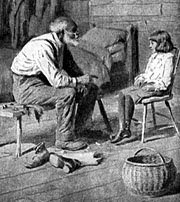 SEE HERE Christine O'Donnell was right, but the laughing numbskulls in the press and our legal minds can't read or understand the actual sense of the original words of the Constitution. The long reign of activist courts have interpreted in much that was never the intent nor ever in the language of the Constitution itself. Thomas Sowell offers his commentary on this important issue that has led to the institutionalization of an operational atheistic nihilism in our schools.
SEE HERE Christine O'Donnell was right, but the laughing numbskulls in the press and our legal minds can't read or understand the actual sense of the original words of the Constitution. The long reign of activist courts have interpreted in much that was never the intent nor ever in the language of the Constitution itself. Thomas Sowell offers his commentary on this important issue that has led to the institutionalization of an operational atheistic nihilism in our schools.
Thursday, October 28, 2010
"Separation of Church and State"? Nope, It's Not In The Constitution
 SEE HERE Christine O'Donnell was right, but the laughing numbskulls in the press and our legal minds can't read or understand the actual sense of the original words of the Constitution. The long reign of activist courts have interpreted in much that was never the intent nor ever in the language of the Constitution itself. Thomas Sowell offers his commentary on this important issue that has led to the institutionalization of an operational atheistic nihilism in our schools.
SEE HERE Christine O'Donnell was right, but the laughing numbskulls in the press and our legal minds can't read or understand the actual sense of the original words of the Constitution. The long reign of activist courts have interpreted in much that was never the intent nor ever in the language of the Constitution itself. Thomas Sowell offers his commentary on this important issue that has led to the institutionalization of an operational atheistic nihilism in our schools.
Subscribe to:
Post Comments (Atom)









Sowell Celebrates Semantic Sophistry
ReplyDeleteDisplaying a stunning lack of understanding of law, language, and logic, Sowell makes much of the absence of the words "separation of church and state" in the Constitution because, in his view, it is as simple as "[e]ither [it] is there or it is not there." Brassy. Oh, wait . . . that's his accusation of others.
The phrase “separation of church and state” is but a metaphor to describe the underlying principle of the First Amendment and the no-religious-test clause of the Constitution. That the phrase does not appear in the text of the Constitution assumes much importance, it seems, only to those who may have once labored under the misimpression it was there and, upon learning they were mistaken, reckon they've discovered the smoking gun solving a Constitutional mystery. To those familiar with the Constitution, the absence of the metaphor commonly used to describe one of its principles is no more consequential than the absence of other phrases (e.g., Bill of Rights, separation of powers, checks and balances, fair trial, religious liberty) used to describe other undoubted Constitutional principles.
Some try to pass off the Supreme Court’s decision in Everson v. Board of Education as simply a misreading of Jefferson’s letter to the Danbury Baptists–as if that is the only basis of the Court’s decision. Instructive as that letter is, it played but a small part in the Court’s decision. Perhaps even more than Jefferson, James Madison influenced the Court’s view. Madison, who had a central role in drafting the Constitution and the First Amendment, confirmed that he understood them to “[s]trongly guard[] . . . the separation between Religion and Government.” Madison, Detached Memoranda (~1820). He made plain, too, that they guarded against more than just laws creating state sponsored churches or imposing a state religion. Mindful that even as new principles are proclaimed, old habits die hard and citizens and politicians could tend to entangle government and religion (e.g., “the appointment of chaplains to the two houses of Congress” and “for the army and navy” and “[r]eligious proclamations by the Executive recommending thanksgivings and fasts”), he considered the question whether these actions were “consistent with the Constitution, and with the pure principle of religious freedom” and responded: “In strictness the answer on both points must be in the negative. The Constitution of the United States forbids everything like an establishment of a national religion.”
Note, too, that as President he vetoed two bills, neither of which would form a national church, on the ground that they were contrary to the establishment clause.
The First Amendment embodies the simple, just idea that each of us should be free to exercise his or her religious views without expecting that the government will endorse or promote those views and without fearing that the government will endorse or promote the religious views of others. By keeping government and religion separate, the establishment clause serves to protect the freedom of all to exercise their religion. Reasonable people may differ, of course, on how these principles should be applied in particular situations, but the principles are hardly to be doubted. Moreover, they are good, sound principles that should be nurtured and defended, not attacked. Efforts to undercut our secular government by somehow merging or infusing it with religion should be resisted by every patriot.
Wake Forest University recently published a short, objective Q&A primer on the current law of separation of church and state–as applied by the courts rather than as caricatured in the blogosphere. I commend it to you. http://tiny.cc/6nnnx